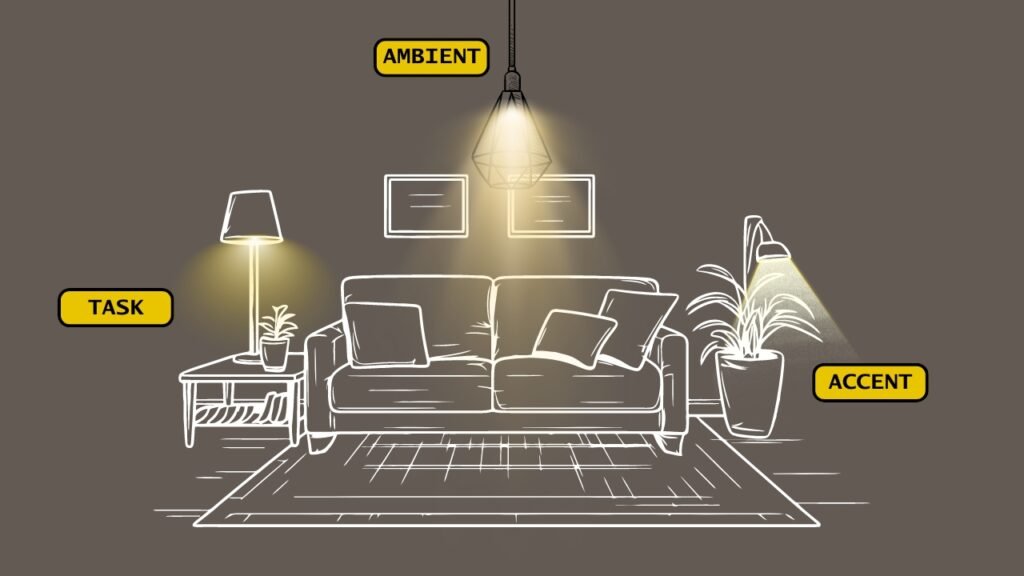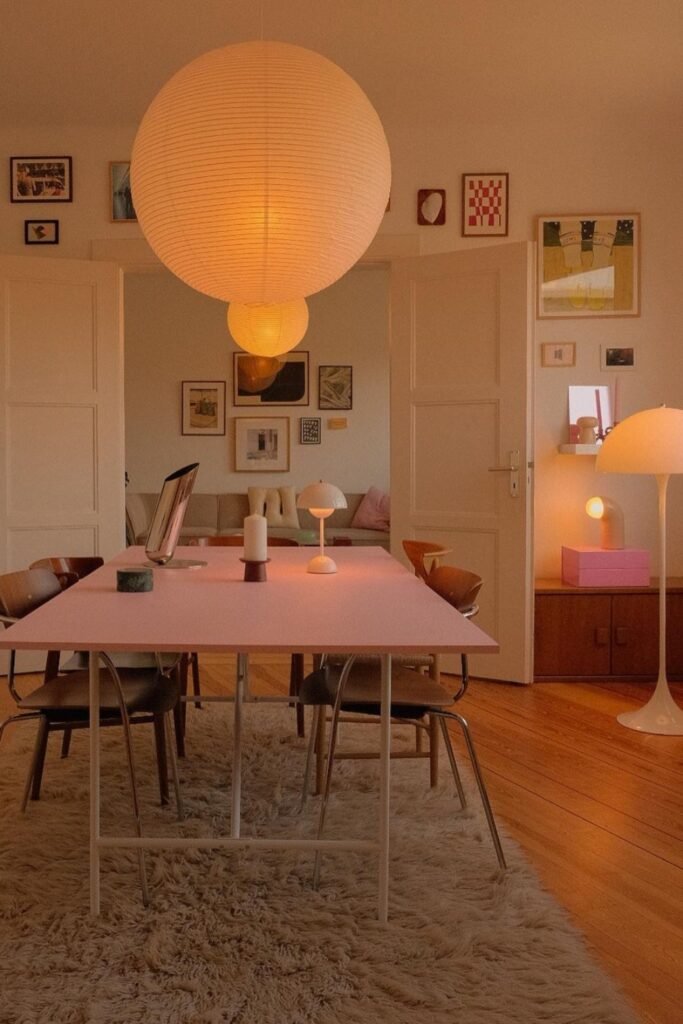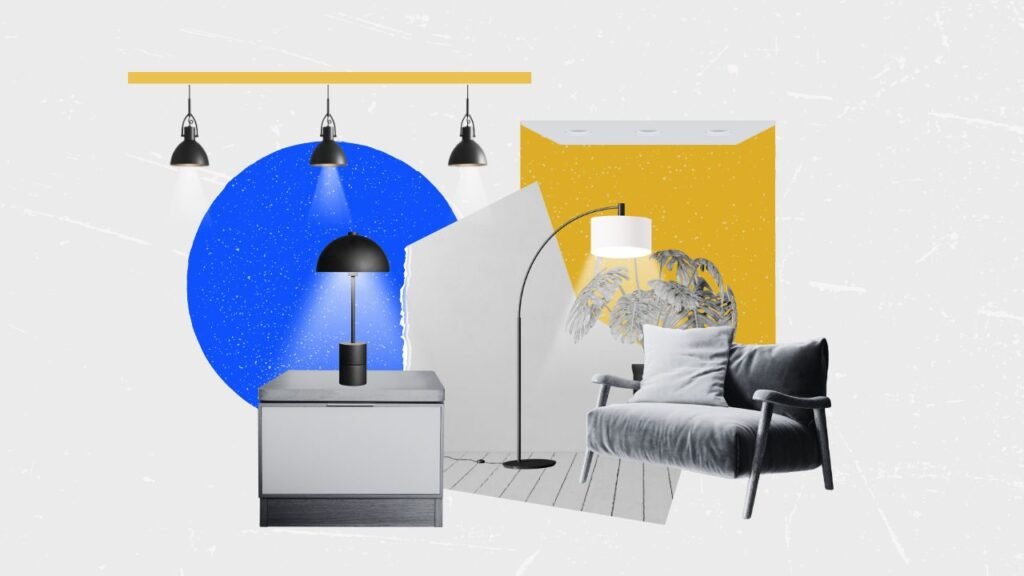One of the magical ways to make your space truly feel like home is through the use of mood lighting. Light is more than just a tool to help us see; it profoundly impacts our emotions and well-being. A well-lit room with a balanced mix of light sources can enhance our mood, productivity, and even our creativity.
A study shows that cool colors with warm lighting are great for boosting the mood compared to warm colors with cool lighting. Warm lighting tends to amplify our emotions, while cool lighting can tone them down or distract us. Although these factors don’t impact physical arousal, they affect how we feel emotionally. Interestingly, reaction times are faster with warm lighting, but creativity is higher with cool lighting.
In this article, we will explore the art of mood lighting—how to use it to create the right feel and atmosphere, improve your space’s ambiance, and make it feel homey.
3 Basic Types of Lighting

Mood lighting is all about using lighting to create an atmosphere. It focuses on layering, utilizing various light sources throughout a room or a space to create a balanced ambiance that can be adapted to different activities and times of day. Mood lighting plays a crucial role in enhancing the overall mood and aesthetics of a room.
“My best advice whatever you’re doing, whatever you want to achieve, is to create three layers of lighting—ambient, task, and accent,” says Patricia Rizzo of the Lighting Research Center. [1]
As mentioned above, there are three basic types of lighting that you should include in every room, especially when you want to create an ambient atmosphere. They are ambient, task, and accent lighting.
Ambient Lighting
Ambient lighting, also known as general lighting, provides the overall illumination in a space. Ambient lighting is the most common type of lighting that will be found in every room. It’s the first layer of lighting and sets the tone of a space.
Ambient lighting radiates a comfortable level of brightness enough for you to see and move around comfortably and safely. Recessed downlights, flush mounting fittings, or chandeliers are the most popular types of general lighting.
Task Lighting
Task lighting provides more concentrated illumination in areas where you perform specific tasks such as reading, sewing, cooking, studying, working, hobbies, and games. You can create task lighting using a variety of light sources, including overhead sources like recessed or track lighting, as well as desk or task lamps.
Task lighting should be adjustable and bright enough to help you see clearly without the harsh glare or annoying shadows and prevent eyestrain.
In the kitchen, task lighting can be provided by under-cabinet lighting or pendants to increase visibility on countertops and food preparation areas. Table and floor lamps provide functional task lighting in living areas, home offices, and bedrooms.
Accent Lighting
Accent lighting is used mainly to create a focal point or add depth to your space. Accent lighting requires at least three times as much light on the focal point as the rest of the room.
Ambient light is not necessarily practical but creates beauty and atmosphere, transforming any space with a touch of drama and flair. It is more frequently used to highlight an architectural feature, a piece of artwork, a sculpture, houseplants, or a collection of objects. Most often, the sources of ambient light are track and recessed lighting and wall-mounted fixtures like picture lights and sconces.
A lighting plan often starts with ambient lighting. Once you have the ambient lighting in place, identify the areas where there will be a need for task and accent lighting. Layering them in a way that supports your activities and creates the atmosphere that you want to achieve when it’s time for relaxation and rest.
Simple Mood Lighting Tips for Your Home
Set the Mood With Color Temperature
One of the most impactful yet often overlooked factors in creating the desired feel in a room is the color temperature of your lighting. Color temperature is a fundamental aspect of light, and it refers to the hue of the light source. It is typically measured in Kelvin (K), with warmer light having a lower Kelvin rating and cooler light having a higher rating.
“In terms of light temperature, residential and hospitality spaces ideally should never be above 3000k,” shares Garrett Hunter. “When lighting becomes too white, spaces end up looking like shopping malls or nail salons.” [2]
Color temperature is an important aspect of color psychology that significantly impacts our moods and emotions. Warm tones promote feelings of comfort and relaxation, while cooler tones can enhance alertness and concentration. That’s why color temperature plays a crucial role in shaping the mood and ambiance of your living spaces. By understanding how various color temperatures influence your perception and emotions, you can make informed choices when creating mood lighting for your homes.

Besides color temperature, it’s essential to understand lumens when choosing lighting fixtures for your room. Lumens are a measurement that quantifies the amount of visible light emitted by a source. The higher the lumen rating, the ‘brighter’ the lamp appears. The higher the lumens, the brighter the light. While watts measure energy consumption, lumens precisely quantify light output.
The number of lumens you need depends on the purpose of the light, the size of the room or a specific area, and the kind of atmosphere you’re looking to create. Start by determining the room’s square footage by multiplying the length and width of the room. For example, a 10 x 10 feet room is 100 square feet, or a 4 x 2 feet kitchen island is 8 square feet.
I’ve put everything necessary into this infographic to help you determine how many lumens you need per square foot. Based on that, you can buy the right bulb for your light fixtures.

“Think about the color of the light itself,” shares Tom Bartlett, founder of Waldo Works. [6]
The color of light plays a crucial role in setting the mood and ambiance of a room. With LEDs, there are numerous options available, from warm white to amber, allowing you to tailor the lighting to suit different spaces and purposes. The right bulb can transform a room, while the wrong one can detract from even the most beautiful fixtures.
Incorporating different hues can significantly impact the atmosphere of your home. Warm white lights, for instance, create a cozy, inviting feel, making them perfect for living rooms and bedrooms. Cooler white lights, on the other hand, provide a crisp, energizing effect ideal for workspaces and kitchens.
Smart LED color-changing lights are a more modern way to improve your mood with color. These lights can be controlled via an app on your phone, offering a spectrum of colors to choose from. This flexibility allows you to adjust the lighting according to your mood or activity, making it a versatile addition to any living room or bedroom.
However, the meaning and effect of colors can vary from person to person. That’s why it’s important to experiment with different lighting colors to find what works for you. Playing with hues allows you to find the perfect balance that enhances your mood and suits your unique preferences.
Layer Lighting

“The best-lit rooms have layers of light that blend well together,” shares architect and designer David Rockwell. [7]
Layered lighting involves using multiple light sources within a room to create a dynamic and adaptable lighting scheme. Instead of relying solely on a central overhead light, a well-layered lighting plan incorporates various fixtures that serve different functions. This method allows you to create different atmospheres and adjust the lighting according to different times of day and activities.
For instance, while a ceiling light is essential for brightening a frequently used space like a kitchen, a living room can benefit immensely from the warm, inviting glow of a combination of floor and table lamps during winter evenings.
Kirsten Blazek of A1000xBetter shares that, for her, the perfect combination involves a mix of accent lighting, floor, and table lamps. Tom Cox of HÁM Interiors likes “a variety of different styles from overhead to wall, task, and low-level table and floor lamps.” [2]
“Throughout the Houses and with our Soho Home Design clients, we use a layered approach positioning light sources at varying heights around the room, on a dimmer switch for a flattering glow. Most spaces will feature a mix of table and floor lamps, wall sconces and a ceiling light – all in different finishes and styles,” says Soho Home Design Team. [8]
Diversifying your lighting fixtures to include wall, floor, and table lamps in addition to the ceiling light can also give the illusion of a larger space. This varied lighting setup helps break up the room and create different focal points, making the space more expansive and open.
Choose the Right Lampshades

“Lighting with shades on gives a softer, more pleasant glow to a room,” shares Carley Summers. [2]
“Lampshades can be a mystery: the size, shape, height, color, and fitting all need to be considered,” shares Tom Bartlett, founder of Waldo Works. [6]
The color of your lampshade can also affect the mood of a room. Health and lifestyle coach Milla Lascelles points out that colors play a significant role in setting the tone of your space: [8]
- Soft Pastels: Ideal for calming spaces like bedrooms and bathrooms. Soft pastels create a serene and relaxing atmosphere.
- Bright Shades: Suitable for social areas like living rooms and kitchens. Brighter colors can uplift the mood and add energy to the space. Yellow, for instance, catches the morning light beautifully and is very uplifting.
- Blue: Known for its calming properties, blue hues can make a room feel serene and help steady your breath.
- Red: Best used in social spaces rather than bedrooms. Red can bring out intense emotions and is more appropriate for lively areas like kitchens or living rooms.
Lampshades aren’t just decorative accents; they significantly influence the quality of light in your space. “Lighter lamp shades will allow more light out into the room, while darker shades will make the light more localized and shine above and below the fixture”, shares Sid Pinkerton. [9] This can be particularly useful in creating different lighting effects in various parts of your home.
Customizing lampshades is also a great way to refresh your lighting without replacing the entire fixture. “You can transform the shape and scale of any fixture or add texture and pattern for more personality,” shares Alex Adamson. [2] She regularly swaps out lampshades for a custom look. This simple hack can breathe new life into old lamps and keep your decor feeling fresh and unique.
Control the Mood With Dimmer Switches
Dimming refers to the ability to adjust the brightness of a lamp or lighting fixture, typically achieved through a dimmer switch that reduces the electrical current flowing to the bulb. This produces a lower light output, creating a softer and more subdued ambiance.
Dimmer switches are the key to transforming your space with the flick of a switch. These affordable and easy-to-install devices allow you to control the mood and feeling of your room’s space just by brightening or dimming the light.
Home design trends are all about personalization, and lighting is no exception. This personalization is made possible with dimmable bulbs. These bulbs not only help save energy but also allow you to create different ambiances throughout the day by adjusting the light intensity. According to Forbes, the ability to control the exact brightness of your lighting can significantly enhance the ambiance of your space.
“They regulate light intensity for a more intimate ambiance,” shares interior designer Marie Burgos. [9]
From a holistic and architectural perspective, dimmable solutions are becoming increasingly popular. This simple yet powerful feature allows you to create different ambiances according to the time of day, season, or activity, whether hosting a lively gathering or enjoying a peaceful evening.
When selecting dimmable lighting, consider the color temperature and brightness levels. Warm, soft light is ideal for promoting relaxation and creating a cozy atmosphere, while cool, bright light is perfect for tasks or activities requiring focus and concentration. Choosing the right bulb type, such as LED or incandescent, based on the desired effect is also crucial for achieving the optimal lighting ambiance.
Go for Lamp

I love lamps for many, many reasons. I love their versatility, as they can be used for all three types of light. I love their flexibility, as they can be moved around easily and without complex installations. I love how aesthetic and stylish they are, with many different styles and finishes from wood to ceramic, metal to natural stone, and fabric to glass. I love the soft, welcoming glow that they bring to any space. They are one of the big reasons I came up with the idea of this article.
“I love the sculptural element a table or floor lamp adds. A room always feels more lived-in and inviting with lamps, and you can’t beat the warm glow they give at night,” shares Alex Adamson. [2]
Table lamps, often the unsung heroes of the lighting world, are brilliant at adding layers of mood and atmosphere to your space. Their soft, inviting glow creates an ambiance of warmth and intimacy, making any room feel cozy and welcoming. You can also use them as accent lights in corners or alcoves to add depth to your room and create a relaxing, feel-good vibe.
Floor lamps are even more versatile than table lamps as they don’t require an elevated surface to shine. Just a small floor space is all they need to cast their spell. They can serve multiple purposes—ambient lighting for a gentle glow, task lighting for focused activities like reading, or accent lighting to highlight a plant, sculpture, furnishing, or architectural features.
Balance Style and Light

via Instagram
“Fundamentally, lighting is practical, but it can also be just as important as an art piece,” shares Tom Bartlett from Waldo Works. [6]
While function is paramount when choosing lighting for your home, it’s equally essential to consider how your lights integrate with your overall aesthetic. The right lighting can seamlessly blend practicality with style, elevating your space to a cohesive and beautifully lit haven.
“Treat your lighting like a piece of furniture. You can have different material finishes like metal, glass, wood, or concrete, for example, which would tie your light fixture to your look.” shares Marie Burgos. [9]
Think of lighting as part of your decor that not only serves a functional purpose but also enhances the visual appeal of your space. Feel free to mix different materials to create a layered and rich aesthetic. Combining metal with glass or wood with concrete can result in a visually captivating space. “Avoid picking a floor lamp, wall sconce, and ceiling light in the same color, finish, and style. It’s good to have a thread of continuity, which will usually relate to the feel of the room, but we don’t want our clients’ homes to have all wooden lighting, for example, or all industrial-style lighting,” says Soho Home Lead Designer Jessica Sims-Wilson. [10]
Finally, let your lighting reflect your personal style by choosing unique fixtures that resonate with your taste and the overall theme of your home. Mood lighting can express your personality and enhance the ambiance of your space. Be it a vintage chandelier, a modern pendant light, or an artistic floor lamp.
Let There Be Light In Unexpected Ways
“Be playful and use lighting in unexpected ways and places. Unexpected moves stand out and can transform the character of a space,” shares Arianna De Gasperis of And Studio. [2]
We’re all for embracing multiple light sources, so don’t hesitate to turn off your ceiling lights and rely on lamps instead. Experiment with the positions of your lamps, and don’t be afraid to change things until you find the perfect arrangement. The proper mood lighting can create a sense of warmth, lift your spirits, help you feel calmer, and boost productivity.
Place small lamps on countertops or shelves in the kitchen and bathroom. It can bring an unexpected touch that adds warmth and a lived-in vibe to these often-utilitarian spaces. Recovering lampshades or painting a light fixture can completely transform your room’s appearance.
Let your creativity shine, and explore the endless possibilities of mood lighting in your home.
Final Thoughts
As we wrap up our exploration of mood lighting, it’s clear that light is much more than just a necessity—it’s a powerful tool that shapes our emotions and our spaces. Using a combination of ambient, task, and accent lighting can create homes that are not only well-lit but also welcoming and inspiring.
Begin with ambient lighting to set the stage, add task lighting to focus your activities, and finish with accent lighting to highlight the beauty around you.
Remember, the key lies in experimentation. Play with different lighting combinations, embrace unexpected placements, and let your creativity flow. With a little planning and these helpful tips to create mood lighting, you can turn any room into a more comfortable and inviting space.
- edgarsclubzim Issue 26 by Edgars Club Zimbabwe
- Designers Agree This Is the Most Common Lighting Mistake
- How Many Lumens Do You Need? A Guide to Getting Enough Light
- Lumens Calculator: How Many Lumens Do I Need for a Space?
- Lumens to watts (W) conversion calculator
- How to light your home – lighting tips from interior designers
- The Secrets To A Well-Lit Room
- How To Boost Your Mood Using Lighting
- These Are the Best Lighting Options for Your Apartment
- How to mix lighting finishes to give your space an eclectic feel
